
 You will of course remember the foolish cult-induced suicides in the Heaven's Gate religion that so shocked the world not too long ago. Reader James H.G. Redekop, whose comments on photography have appeared here previously, informs us:
You will of course remember the foolish cult-induced suicides in the Heaven's Gate religion that so shocked the world not too long ago. Reader James H.G. Redekop, whose comments on photography have appeared here previously, informs us:
I just remembered another case of ignorance of photography driving pseudoscience, as with "the creatures" and the Moon Landing Hoax: the "Saturn-like object" that was supposedly behind Comet Hale-Bopp, the one that was supposed to be the spaceship the Heaven's Gate cult suicides were trying to get to, was the result of another common digital photography glitch.When a cell in a CCD (the light-sensitive chip which digital cameras use) receives too much light, it overflows and dumps the excess signal to its nearest neighbors in the same row of cells. Those neighbors may themselves overflow into their neighbors in the row. If the light falling on the cell is strong enough, you will get a straight bar through the image of the light. This is often seen in CCD astrophotographs, in which the brightest stars have strong bars through them. The late Chuck Shramek, who took the photograph in question and promoted it as something mysterious, was apparently ignorant of this fact about CCDs.
Or perhaps amateur astronomer Shramek decided not to spoil a perfectly good story.... You see Shramek's photo here, with the "Saturn-like object" indicated that, with a misguided guru's urging, led so many to suicide.
Reader Jun Okumura notes, re my variations on the Henriette Syndrome, that:
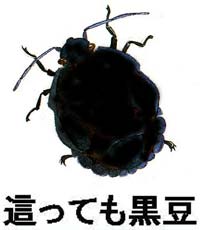
There is an old Japanese saying; "Hatte mo kuromame." It means, literally: "It's a black bean, even though it (obviously a bug) crawls." You use it in an argument against somebody who refuses to back off from an assertion that has been proven wrong to everybody's eyes. Another example of the universality of humanity's foibles.
Thanks, Jun. It appears that Lady Henriette really got around....!
Reader Nigel Groves tells us that in my 20th April page last year, I wrote the following:
In my own collection of fakery, I have a felt-tip marker that is sold to gullible hi-fi enthusiasts who are worried about the laser beam in their CD player wandering about and causing audio image degradation and/or eye damage. The user traces the marker around the rim of the CD, leaving a green line that protects against this imaginary danger.
Then he tells us:
It's just been announced (on the BBC and in the London Times) that this very same technique is a simple but effective method of overcoming the latest copy protection measures put into place by CD manufacturers.I'm not making any particular point here, I was just amused that a con-artist came up with an idea to make money out of the gullible that in time has turned into something that is seriously worrying CD manufactures for a completely different reason.
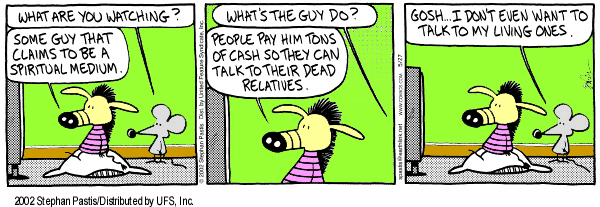
Cartoonist Stephan Pastis, joining artist Scott Adams, Scott Kurtz, and others, has granted us permission to run this May 27th strip of "Pearls Before Swine" for your education and amusement. His note of permission was accompanied by kind words of appreciation for this site. Thank you, Stephan.
Reader Steven Legge opines on why belief in the paranormal and pseudoscience is so prevalent:
I think the problem lies in the educational system. Too much emphasis is placed on the memorization of the answers, and not enough on asking questions. That and the world has a epidemic lack of common sense which allows for people like Uri Geller and John Edward to walk in and prey on the ignorant.
Agreed! Exactly why the JREF exists, Steven!
Reader Jonathan Fox offers us, re the current craze for "speaking to the dead":
I thought it would be fun to draw up a list of statements that have about a 100% chance of being accurate when describing a female relative who has passed on. Here are some that I came up with very quickly:
She used to get quite upset when things didn't go her way.She had difficult times in her life.
She was very optimistic about certain things.
She loved being praised.
She used to get quite nervous about certain things.
She kept a lot to herself.
She was always looking for stability in her life.
She had many unfulfilled ambitions.
She loved you very much but didn't always show it.
She loved bright colors.
I'll add to that list, which could go on forever:
She often lost her temper, but contained her anger.She thought that her well-meaning criticisms were sometimes ignored by her loved ones.
Small kindnesses meant a lot to her.
She could conceal her grief from you, she thought.
When she snapped at you, she always regretted it afterward.
A perfect example of how accepting and forgiving a victim of John Edward can be, occurred last year when an enthusiastic young woman, interviewed backstage following an on-camera "reading" with Edward, said:
You know what really clinched it for me? John described Mom as exuberant and outgoing. He said she came through loudly and just wouldn't stop running on and on. And I can tell you, that wasn't Mom at all when she was "on this side"! Oh, no. She was very quiet and soft, never raised her voice. She was timid! It's just so good to know that now she's happy and free and can express herself!
My translation of this: Edward was absolutely wrong in guessing the personality of the deceased, but the victim — her daughter — wanted so much for the search for her dead mother to work, that she rationalized this abysmally bad guess into a success. Some people just won't learn. But you knew that all along, didn't you, John?
Reader Stephen Bauer, of Portland, Oregon, gives us this observation on the silly "rods" anomaly we've been discussing here:
Most rod photos I've seen are produced in areas where one might expect insects to be present, and also in areas where there are sharp light/dark contrasts. Cave entrances come to mind, also fall sporting events played at night, where the critters are attracted by the bright lights on portable TV video cameras. Also, most photos show a fairly opaque rod body but limbs that appear translucent. This is what I would expect from insect photography, as the body would occupy the line of flight (as "seen" by a camera) for a longer period of time than the wings, which are moving both up and down, as well as horizontally on the flight path, assuming that the creature is flying parallel to the ground. I am particularly unpersuaded by photo comparisons such as: "This particular photo depicts an insect in flight, that particular one depicts a 'rod' doing its thing, and the two photos don't resemble one another, therefore rods aren't insects."It's bugs, boss. And those who think otherwise are just plain buggy.
Well, Stephen, I think you're quite right. In response to the request last week for readers to attempt replications of the "mysterious" rod photos, Henrik Herranen of Finland, who already gave us another fine replication — of the "creature" in the Egyptian tomb — has provided the same for the rods, for this week's page. Henrik will, I hope, forgive me for truncating his excellent article for inclusion here. The whole piece can be seen at: http://www.cs.tut.fi/~leopold/stmp/0205_RandiRods, but will be available there for only a short time, so get to it and enjoy the detailed description. Due to weather conditions, Henrik had to construct an artificial bug.....

The page http://www.roswellrods.com/ shows the phenomena called "Roswell Rods," which are claimed to be pictures of unknown life forces. There are incredible claims, an abundance of pictures, and even an analysis of a rod by Dr. Bruce Maccabee, a UFO researcher. This article was written to show how Roswell Rods can easily be created and photographed.
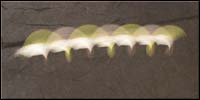
On the site, you can see several pictures that were somewhat like the one shown here, a very long rod. I don't think I saw any pictures on the site quite of this caliber. So, how was this image generated? It's actually quite easy. Have a dark background and a bright, swirly object, preferably in the sun. Ideally it should be a bug, but if it's only 5 degrees above freezing, as it was here when I did this, a paper "swirly" will do, as shown:
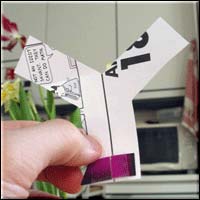
To build a paper swirley, take a piece of paper, preferable a page from a Dilbert calendar — to remind you of stupidity in all its forms. Cut it approximately to a Y-shape. Tape some cardboard pieces to the bottom end to give it proper weight (the magenta parts). Then bend the other wing towards you (not shown in the picture) and the other one in the other direction. Now you have it. When you drop the thing, it should fall swirling. Just drop it and photograph it (or shoot the bug) a few times. An exposure time of 1/8s or longer is nice for a swirly. For a real bug, 1/60s is often enough, as it flaps its wings much faster.As can be imagined, timing is of the essence when shooting these damn things, especially if you are doing it alone using a time-delayed shot. So prepare to take a kadzillion shots, and preferably use a digital camera so that you can see when you can stop.
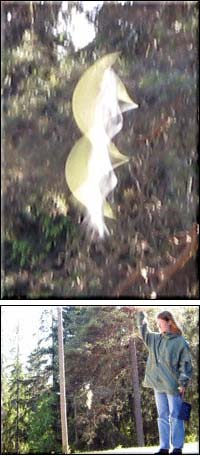
Here is yet another rod, which has, as the one in the previous picture, a very detailed tail structure, and the original picture of [my wife] Emma dropping the swirly, of which the previous photo was a partial enlargement. Because of a slight wind, the rod is a little bit to the left of Emma.
Then Henrik offers us his observations on a renowned UFO scientist's analysis of these "creature" photos....
Dr. Bruce Maccabee's Rod AnalysisAt the Roswell rods page, there is an analysis by a Dr. Bruce Maccabee at http://brumac.8k.com/BaseJumperRods/BaseJumperRods.html. While flawed at almost every level, there is one particular error on which I want to especially comment. Of the pictures on the page mentioned, Dr. Maccabee says:
Although the well-known frame rate for video is 30 per second, the picture can be created in much less than 1/30 sec. In this case the time to create one video "field," which shows the whole scene in front of the camera, was 1/2000 of a second. The video camera was operated with a short shutter time to "stop" the motion of the falling base jumper. That is, the shutter time was short enough so that the image of the base jumper was not smeared by his own motion (downward) during the time that a complete complete "field" was generated by the camera electronics.I'm not going deeper into the mundane fact that video fields last for 1/60 s and that the quoted figure of 1/30 s has little relevance when talking about temporal video resolution. But, the claim that the pictures shown are shot at 1/2000 s instead of 1/60s, is completely bogus. Let's take a look at the very first picture on the page — go on, click the link above and then come back. Yes, as Dr. Maccabee said, the jumper doesn't suffer from a lot of motion blur. But — and here comes a most important point — look at the rock above the jumper. The rock is clearly (motion) blurred! So, what has happened?
The video camera operator has followed the movement of the jumper, which has had the effect of showing motion blur of the rocks behind him. This is very basic, and the fact that Dr. Maccabee has failed to notice this, invalidates the rest of the article, since it's based on the incorrect assumption that a short exposure time makes it impossible for the rod in the picture to be an insect.
Notice, by the way, how this picture is exactly as I said a good rod picture should be: the main object of the picture is in shadows, but the guy shooting is on the top of the ledge, almost certainly in sunshine, where insects have great chances to register as rods.
Henrik, you've done it again. As I wrote last week, our readers are falling right in with our principles of critical thinking and analysis, and contributing the results here. Thank you, very much, for your fine work, Henrik.
As if we needed more on this subject, reader Don Finan points out that 'way back in February of 2000, there were already very effective analyses of these artifacts being published. I strongly suggest that you go to two sites, http://www.amsky.com/ufos/rods and http://www.opendb.com/sol/bugs.htm, to see just how well such matters can be, and have been, discussed. You will also see there just how vituperative and angry the "believers" can be when their favorite delusions are questioned and demolished. Their hatred and fear is made very clear there.
Reader Scott S. Wagner tells us how he battles with false beliefs among his students:

I'm a middle school science teacher in California. Whenever I cover astronomy, I get lots of questions about astrology. Many students want to learn to locate "their" constellation (harmless enough), but many seem convinced that horoscopes are at least "sometimes" true. So I conduct an experiment. I bring to class a copy of the previous day's horoscope, with the signs and dates blanked out, and with the order of the predictions altered (to correct for students who may recall that their sign is the second from the bottom, for example). I ask students to read all the horoscope, and choose one that best agrees with the day they had yesterday, the day for which the advice/predictions were intended. I then poll students for their choices and for their actual dates of birth.Over the course of a full day and about 120 students, I invariably find that around one out of twelve correctly choose their own horoscopes, and the rest don't. I explain ahead of time why I expect about a one-in-twelve success rate, and how that will strongly indicate that horoscopes might as well be randomized. Unfortunately, while this works very well, a handful of especially gullible students usually conclude that the horoscopes actually work for the one-in-twelve group who correctly selected their own signs.
I guess I can't win 'em all.
No, Scott, you can't win 'em all, but those you do win, are rewarding indeed. That's how we operate here at the JREF.
Reader/JREF member Rob Martin, obviously an experimenter at heart, approached the "file drawer" ("Filer drawer?) problem as related to UFO reports. We've discussed UFO "expert" George Filer here previously. Rob gives us this fine report:
In September 2000, suspecting that "professional" UFO organizations didn't bother to investigate UFO sightings very well, if at all, I submitted to MUFON [Mutual UFO Network] Eastern Regional Director George Filer a hoax UFO sighting report. I made it typical except for one detail — I made the shape of the UFO atypical from the standard by describing it as boxy and angular, in anticipation of a suspicion I had that reports are altered. I provided three different ways (telephone number, address, email address) by which an investigator could contact me.Long story short — MUFON & Filer bought it hook, line, and sinker, and though that is no surprise, this might be: even after it had been identified as a hoax it remains in their published archives unidentified as a hoax.
Main points:
1) My hoaxed sighting was never investigated.
2) Filer changed my description of the UFO from "boxy and angular" to "disc shaped." I suspect this practice of changing the details helps the reports to fit a certain preconceived pattern and seem more believable.
3) By way of explanation after discovering the hoax, Filer said that UFO sighting reports sometimes go "several months" before they are investigated. Anticipating some disclaimer like this (hey, I spent a lot of time setting this thing up for maximum effect), I then informed Filer that I had submitted a second hoaxed report and would be looking forward to the MUFON investigation within "several months."
4) Filer began, in the very next issue of his internet newsletter "Filer's Files," to include that disclaimer you quoted in last week's Commentary. I cannot be 100% sure it was due to my actions, but I shamelessly claim credit anyway, tee hee. In successive issues there is no disclaimer, there is next the issue with my hoaxed report unidentified as such as yet, and there is next an issue warning readers of the hoax and containing the new disclaimer.
5) I have not checked in several months, but last time I did this disclaimer was buried so deep into the Filer's Files issue, that no one could be reasonably expected to notice it. It was even below his advertisements for his real estate sideline.
6) Other organizations (Jeff Rense, Sightings.com for one) reprinted the identified hoaxed UFO report.
7) My second hoaxed report (submitted with an entirely different name, address, telephone number, etc.) has never been investigated, though nearly two years have passed.
Primary conclusion:
UFO reports go uninvestigated, but are left in the files as if they had been, to be read by people who assume they have been. Hoaxed reports are left in as well, even after they've been identified as such. Therefore, there is an unknown and now unknowable percentage of UFO reports which are uninvestigated and/or hoaxes, and most certainly there are reports which are both. If a barrel of apples contains just one poisoned apple, and you cannot tell outwardly which apple is the poisoned one, you must toss out the entire barrelful. So it is with UFO reports.
I have all the original material on this, including Filer's disclaiming statements, and the identifying issue numbers to locate the exact Filer's Files issues where this all occurred. You and the JREF are welcome to them.
PS: This event is jokingly nicknamed "The Trojan Rabbit Affair" among my skeptical friends because I used a particularly obnoxious little believer and MUFON Junior Investigator with the message board name of "White Rabbit" as my dupe to excitedly run to Filer & MUFON to report that a an evil message board skeptic (me) had just admitted that a certain UFO report was a hoax.
In closing this week, I suggest that in order to see for yourself how absolutely inane some people can be when they are determined to find significance where there is none, go to http://www.glennbeck.com/news/05172002.shtml This is a disheartening example of examining a tragedy to see if it was, somehow, predicted. Reader Todd Weekley came upon this one, and he could not decide whether the people behind it were serious, or not. I'm sorry to say that I believe they are serious....
I want to thank the many readers who sent me their comments about the passing of Stephen Jay Gould. It was satisfying to know that so many were influenced by him, and that his legacy lives on so strongly. We celebrate his existence while we mourn his loss.
There! I did it! Did you notice? This week, I used almost exclusively material submitted by readers. I'm happy to have this sort of participation, and I hope that it will continue. By creating an atmosphere in which we can all share our thoughts and opinions, this web page is accomplishing what we set out to do in the first place. This is very gratifying indeed.
Keep it coming!
